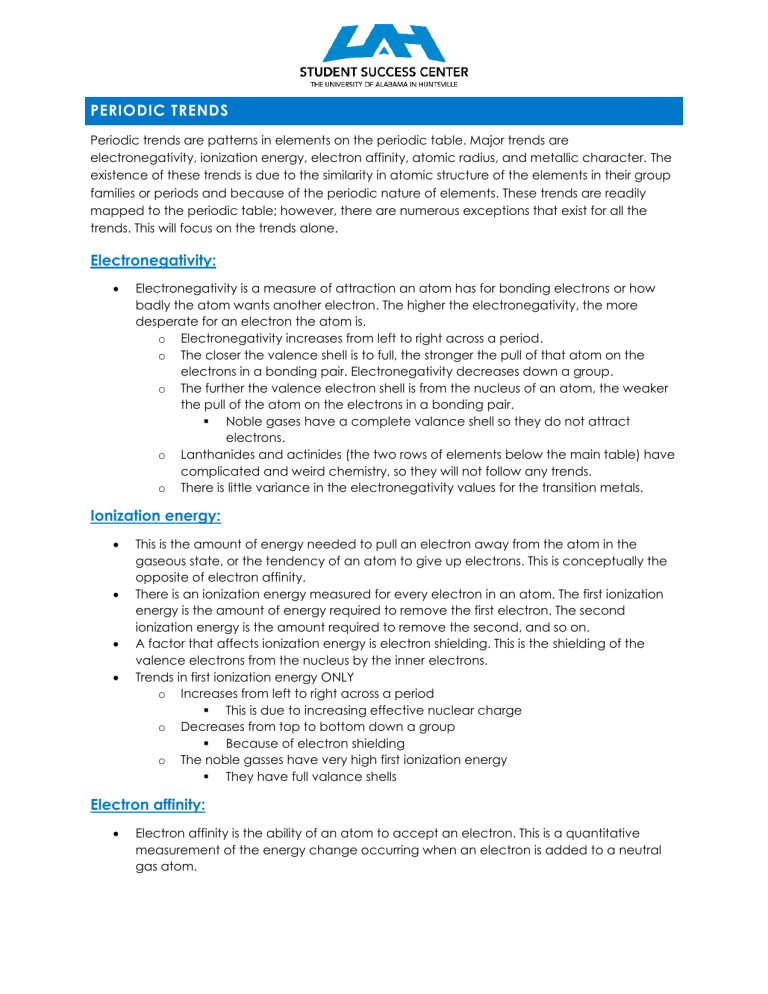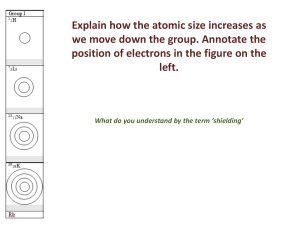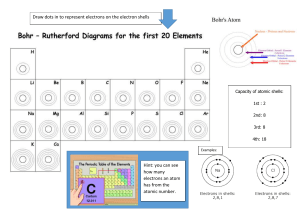
PERIODIC TRENDS Periodic trends are patterns in elements on the periodic table. Major trends are electronegativity, ionization energy, electron affinity, atomic radius, and metallic character. The existence of these trends is due to the similarity in atomic structure of the elements in their group families or periods and because of the periodic nature of elements. These trends are readily mapped to the periodic table; however, there are numerous exceptions that exist for all the trends. This will focus on the trends alone. Electronegativity: Electronegativity is a measure of attraction an atom has for bonding electrons or how badly the atom wants another electron. The higher the electronegativity, the more desperate for an electron the atom is. o Electronegativity increases from left to right across a period. o The closer the valence shell is to full, the stronger the pull of that atom on the electrons in a bonding pair. Electronegativity decreases down a group. o The further the valence electron shell is from the nucleus of an atom, the weaker the pull of the atom on the electrons in a bonding pair. Noble gases have a complete valance shell so they do not attract electrons. o Lanthanides and actinides (the two rows of elements below the main table) have complicated and weird chemistry, so they will not follow any trends. o There is little variance in the electronegativity values for the transition metals. Ionization energy: This is the amount of energy needed to pull an electron away from the atom in the gaseous state, or the tendency of an atom to give up electrons. This is conceptually the opposite of electron affinity. There is an ionization energy measured for every electron in an atom. The first ionization energy is the amount of energy required to remove the first electron. The second ionization energy is the amount required to remove the second, and so on. A factor that affects ionization energy is electron shielding. This is the shielding of the valence electrons from the nucleus by the inner electrons. Trends in first ionization energy ONLY o Increases from left to right across a period This is due to increasing effective nuclear charge o Decreases from top to bottom down a group Because of electron shielding o The noble gasses have very high first ionization energy They have full valance shells Electron affinity: Electron affinity is the ability of an atom to accept an electron. This is a quantitative measurement of the energy change occurring when an electron is added to a neutral gas atom. Like ionization energy, there is an electron affinity measured for an atom for each successive electron added. Trends in first electron affinity o Tend to be negative, meaning energy is released when the electron is added. o The amount of energy released increases left to right across a period. o The amount of energy released decreases down a group. o The noble gases have positive first electron affinities, meaning they require energy to accept an electron. Atomic radius: The atomic radius is one-half the distance between the nuclei of two atoms of the same element. o Increases right to left (backwards) across a period. Electrons are added left to right across a period to the same valance shell. Simultaneously positive protons are added to the nucleus. The effect of the positive protons is greater than the negative electrons, so there is a higher effective nuclear charge. The nucleus attracts the electrons more strongly, decreasing the atomic radius. o Increases down a group. Valance electrons are added to shells further away from the nucleus. As shells are added, the outer electrons are shielded from nuclear attraction from the inner electrons via electron shielding. Metallic character: Metallic character is a set of physical and chemical properties including reactivity, conductance, ductility, and malleability. One important characteristic is how readily an atom can lose an electron. o Metallic character decreases across a period. This is due to the increasing attraction between valence electrons and the nucleus across the period. o Increases down a group. This is because the atomic size is increasing, which causes the outer electron shells to be farther away. This decreases effective nuclear charge, making electrons to be lost more readily. For more information, visit a tutor. All appointments are available in-person at the Student Success Center, located in the Library, or online.




